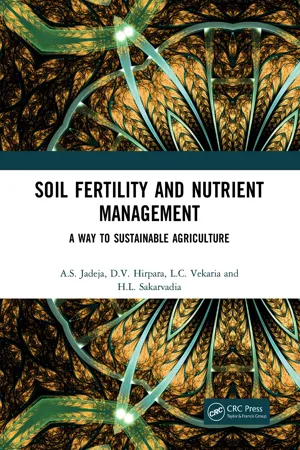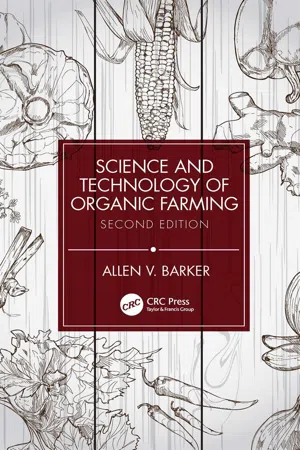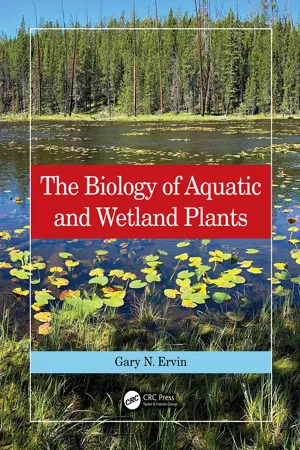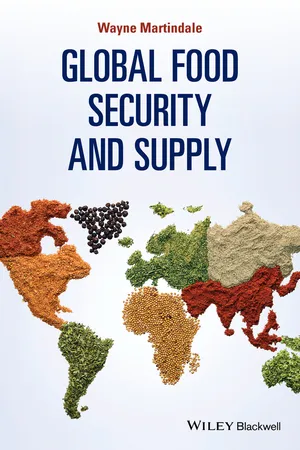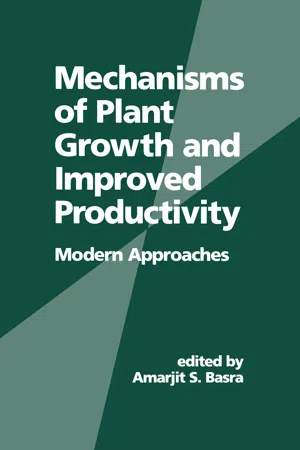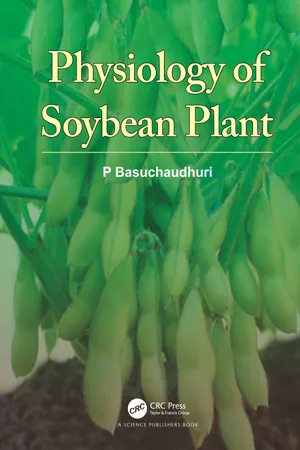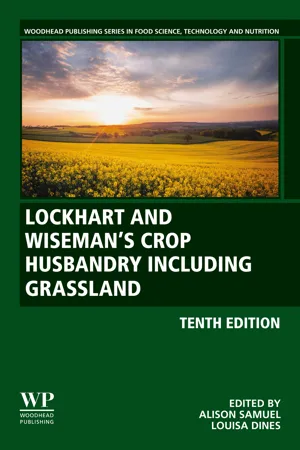Biological Sciences
Plant Nutrition
Plant nutrition refers to the process by which plants obtain and utilize essential nutrients for growth and development. These nutrients include macronutrients such as nitrogen, phosphorus, and potassium, as well as micronutrients like iron, zinc, and manganese. Plants absorb these nutrients from the soil or water, and deficiencies or imbalances can lead to stunted growth, poor yield, or susceptibility to diseases.
Written by Perlego with AI-assistance
Related key terms
8 Key excerpts on "Plant Nutrition"
- eBook - ePub
Soil Fertility and Nutrient Management
A Way to Sustainable Agriculture
- A.S. Jadeja, D.V. Hirpara, L.C. Vekaria, H.L. Sakarvadia(Authors)
- 2021(Publication Date)
- CRC Press(Publisher)
CHAPTER 2PLANT NUTRIENTSA s we know that all living organisms require food for survive, growth and reproduction. Therefore, every organism takes food and utilizes the food constituents for its requirements of growth and development. A series of processes are involved in the synthesis of food by plants, breaking down the food into simpler substances and utilization of these simpler substances for life processes. Nutrition in plants may thus be defined as a process of synthesis of food, its breakdown and utilization for various functions in the body.Green plants synthesize their food materials from simple constituents (elements). Therefore, plants require a large number of elements which is taken up by the plants either from air and water or soil. In soil, the minerals (elements) are derived from minerals or are mineralized during the biological breakdown of organic matter. The mineral nutrients are taken up by the plants in the form of ions and incorporated into the plant structure or stored in the cell sap. One hundred and nine elements have been identified in the periodic table so far. Most of these exist in the earth’s mantle, earth’s crust and soil, though the magnitude of their occurrence varies. More than 60 elements are taken up by the plants. Based on their essentiality, they are grouped in to three categories viz. essential, beneficial and non essential. Before moving further, let us understand some of the key terms used in this chapter.Element: It is the simplest form of the substance. It has definite properties and can not be change in other form. For example, carbon, nitrogen, phosphorus, potassium, iron, mercury etc.Compound: When two or more elements combining to gather in a definite proportion and form third substance, the product is called compound. C + O2 =CO2 - eBook - ePub
- Allen V. Barker(Author)
- 2021(Publication Date)
- CRC Press(Publisher)
Soil acidity has little direct effect on crop growth except in strongly acidic conditions (pH < 4.0) or strongly alkaline conditions (pH > 11.0). Physical factors of soil fertility include conditions such as soil depth, water-holding capacity, drainage, aeration, tilth, temperature, and nutrient-holding capacity. Biological factors include conditions such as the presence of harmful organisms, such as plant diseases, weeds, and insects, and the presence of beneficial organisms, such as microorganisms, that carry out mineralization of organic matter and nitrification of ammonium and that live in symbiosis with plants. Chemical, physical, and biological factors are interrelated, and sometimes it is difficult to place a soil property into one of the categories. Soil fertility is an integration of these factors.Plant Nutrition is the study of the uptake, transport, and function of nutrients in plants. Plant nutrients are known also as essential elements. These are chemical elements that are required for plant growth. They must be supplied whether the system is organic or otherwise. For a chemical element to be considered as a plant nutrient, several criteria must be met. These criteria are (1) The element must be required for plants to complete their life cycles. Each element has a direct effect on plant growth or metabolism. Deficiency of an essential element will result in abnormal growth or premature death of plants; (2) The requirement for these elements is universal among plants, that is, all plants, not just a few require these elements. If some plants require an element and others do not, the element is not considered a nutrient but a beneficial element; and (3) No other element will substitute fully for an essential element. Partial substitution might occur among some elements, but each plant nutrient has a role for which no other element can substitute. Today, 17 chemical elements (Table 2.1 - eBook - ePub
- Gary N. Ervin(Author)
- 2023(Publication Date)
- CRC Press(Publisher)
7 Plant Nutrition and Sediment BiogeochemistryDOI: 10.1201/9781315156835-77.1 Plant Nutrition
In Chapters 5 and 6 , we talked extensively about three elemental nutrients needed by plants: carbon, oxygen, and hydrogen. However, plants require much more than these to live, develop normally, and successfully reproduce. The essential nutrients that plants require can be broken into those that are required in relatively large amounts (termed macronutrients) and those that are required in usually much smaller amounts (micronutrients). These are given in Tables 7.1 and 7.2 , along with typical concentrations in dried plant tissues, their biochemical or physiological roles within the plants, and some of the usual symptoms of nutrient deficiencies. Other nutrients may be required by some species, in much smaller, trace, concentrations, or by symbionts of the plants themselves. Symbiotic nitrogen-fixing bacteria that will be introduced later in the chapter, for example, require trace quantities of nickel and cobalt (Barbour et al. 1999 ; Taiz et al. 2015 ); although not a direct requirement of the plants, deficiency of these nutrients in the soil can impact health of plants that rely on the bacteria.In Chapter 5 we also learned a bit about how conditions within wetland soils and sediments influence the availability of nitrogen, manganese, iron, and sulfur (e.g., Figure 5.25 ). We saw there that radial oxygen loss (ROL) is critical for reducing toxicity that would result from the reduced forms of some of these elements (Table 5.2 ). In the case of nitrogen and sulfur, however, some plant species preferentially take up oxidized forms (Barbour et al. 1999 ; Cronk and Fennessy 2001 - eBook - ePub
- Wayne Martindale(Author)
- 2014(Publication Date)
- Wiley-Blackwell(Publisher)
3 The Scientific Basis for Food Security3.1 The Supply of Essential Plant Nutrients
The conversion of solar energy into biomass through photosynthesis is dependent on several factors that can limit the amount of biomass or crop yield achieved. The notable limiting factors that growers and farmers are constantly trying to optimise for greatest crop yield are light, temperature, water, and plant nutrients. While light and temperature limitations are principally dealt with by sowing periods and protecting crops from weather, plant nutrients, and water are potential limiting factors that are perhaps most under the control of the management system the grower chooses. For example, limitations to water availability can be achieved by planning storage, capture, and irrigation of water resources, but ultimate availability may well be outside the control of growers. Plant nutrients are supplied as mineral fertilisers or organic manures, and these materials supplement nutrients available from the soil. What is critical to consider at this stage is that most essential nutrients required in foods by human beings are derived from biomass derived from crops and the agronomic decisions made during production will influence dietary quality.Plant nutrients are found in crops at distinct concentrations that correspond to the ideal range for optimal plant health and the functioning of metabolism within the plant. It is possible to determine optimal physiological and metabolic states by the analysis of specific nutrients in field trials. There are critical values of plant nutrients below which there will be a decrease in yield, and the use of tissue analysis by agronomists is proving useful in determining critical nutrient values below which yield loss may become apparent. Critical values can also be used to manage crops at a particular level of production and determine optimal application of nutrients as fertilisers. The response curve of yield, metabolism, and physiological variables is generally hyperbolic, that is an initial linear phase of increase (of biomass yield) at low concentration of a variable such as nitrate, followed by a curvilinear phase at higher concentrations (Figure 3.1 ). This type of response can be viewed in terms of limiting factors and control theory, where several factors are involved in limiting the rate of response associated with a system. The mass of nutrient required per hectare of land is surprisingly stable across the plant kingdom and follows the type of responses shown in Figure 3.1 - Amarjit Basra, Amarjit Basra(Authors)
- 2021(Publication Date)
- CRC Press(Publisher)
1 ], demonstrates that for a low rate of supply of a nutrient, addition of an increment can give a big increase in yield, but for every additional increment supplied the increase in yield is progressively smaller. This shows both that the biggest increase in yields can be obtained by supplying fertilizers to crops that would otherwise be growing in nutrient-poor soils and also that supplying fertilizers to nutrient-rich soils can give rise to wastefully high concentrations of nutrients in the soil.From these two concepts it can be seen that there is a demand for knowledge about the optimum rates of supply of different nutrients that give maximum plant yields without undue waste of fertilizers. This is especially important now that an excess of some nutrients in soils has been recognized as causing environmental problems. Furthermore, there is considerable interest both in how a shortage of one or more nutrients affects the growth of plants when other nutrients are adequately supplied, and how excesses of nutrients influence plant growth. Given that there is now the means to study plant physiology at the molecular level it is hardly surprising that these topics are considered in a range of organizational levels, from ecosystems to organelles. In this review we will concentrate on three key aspects of plant mineral nutrition as the subject is currently being studied:- The physiology of nutrient uptake, translocation, and assimilation, and how this relates to the growth of whole plants.
- How plants respond to imbalances in the supply of elements and how this affects their growth.
- How conditions in the rhizosphere affect nutrient availability, and how plants themselves influence these conditions.
PHYSIOLOGY OF NUTRIENT ASSIMILATION
Uptake Mechanisms
Nutrient ions are taken up by plants from hydroponic solutions or soils, where they occur in a wide range of concentrations. Some gaseous compounds, or nutrients supplied in liquid fertilizers, may be taken up through the foliage, but it is the plant root that provides the usual site for entry of mineral nutrients.- eBook - ePub
- P Basuchaudhuri(Author)
- 2020(Publication Date)
- CRC Press(Publisher)
CHAPTER 6Plant Nutrition
Nutritional requirements of crops have always been of interest but more so now than ever because of changing economic and environmental dynamics in crop production. Increased demands for limited water supplies for uses other than agriculture, along with the resulting depletion of non-renewable water resources, higher energy and fertilizer costs, adoption of genetically modified crops, and climate change (Allen et al., 2012), alter the landscape of crop production. Concerns over agriculture’s contribution to increased water consumption and its possible contamination of water resource sources through current production practices also stimulate a need for more current information about the nutrient requirements of most of our agronomic crops.Deficiencies in N, P or S all result in a shift in dry matter allocation in favour of root growth (Ericsson, 1995). However, simple measurement of the relative biomass of the shoot and root fails to reveal the many subtleties of the roots’ response to changes in nutrient supply. Note, that it seems to be a general rule in plants that primary root growth is much less sensitive to nutritional effects than is the growth of secondary or higher-order roots.6.1 NitrogenThe development of N-fixing nodules on legume roots is a highly regulated process. The number of nodules on a root system is controlled by a mechanism called ‘autoregulation’, in which previously formed or forming nodules suppress the development of further nodules (Schultze and Kondorosi, 1998). Split-root experiments have established that autoregulation acts systemically and that the autoregulatory signal originates in the shoot (Kosslak and Bohlool, 1984). - eBook - ePub
A Gardener's Guide to Botany
The biology behind the plants you love, how they grow, and what they need
- Scott Zona(Author)
- 2022(Publication Date)
- Cool Springs Press(Publisher)
5
WHAT A PLANT NEEDS: NUTRIENTS
LIKE ALL CREATURES, PLANTS NEED TO EAT .They need to take in nutrients. Two essential nutrients, carbon dioxide and oxygen, come in gas form, from the air, but all the other nutrients necessary for life arrive dissolved in water and are taken up by the roots (and sometimes by the leaves). The so-called macronutrients are those needed in relatively large amounts. The micronutrients, elements like copper, zinc, iron, etc., are needed in smaller quantities, but they are just as essential to plant life as the macronutrients.One of the most vivid lessons I learned as an “Aggie” at a large land-grant university was how Liebig’s Law of the Minimum relates to soil fertility and crop production. Liebig’s law states that growth and productivity are dictated not by total soil nutrients available, but by the one nutrient in shortest supply. The lesson was driven home by the depiction of a barrel whose staves represented the nutrients needed for growth. The staves were of varying lengths, but the water-holding capacity of the barrel (the visual stand-in for crop productivity) was determined by the shortest stave. Liebig’s barrel is an excellent reminder of how plant growth is limited by those nutrients in shortest supply.All the necessary nutrients must be supplied to the vegetables grown hydroponically .Liebig’s barrel visualizes how plant growth, represented by the water in the barrel, is limited by the least available nutrient, represented by the shortest stave .The other lesson I learned as an undergraduate was the mnemonic: C. Hopkins Café managed by my cousin Moe Chloride - Alison Samuel, Louisa Dines, Steve Finch, Gerry P. Lane(Authors)
- 2022(Publication Date)
- Woodhead Publishing(Publisher)
4: Fertilisers and manures
Abstract
This chapter explains the importance of optimising Plant Nutrition and soil fertility for crop production. It discusses the main plant food elements required by crops, both major nutrients and micronutrients (trace elements). It describes the fertiliser materials used on-farm and explains the differences between straights, compounds, complexes and blends, as well as considering application practices and methods for both solid and liquid fertilisers. Organic materials, both produced on- and off-farm are valuable nutrient sources for crop production and can often be additionally beneficial as soil conditioning agents. Livestock manures and slurries, together with a range of other organic materials, are described in terms of their characteristics and best use. Finally, the chapter considers the effect of fertilisers and manures on the wider environment.Keywords
Compound; Fertiliser; Nitrogen; Nutrient; Organic material; Phosphorus; Potassium; Straight4.1. Introduction
Good nutrient management is a key aspect of viable and sustainable agricultural production. There is the challenge of increasing food production for the growing global population whilst ensuring that environmental impacts are lessened. Supplying optimal levels of nutrients for crop and livestock production as part of profitable farming businesses involves extensive decision making associated with the importance of integrated farming systems and their connection with the wider environment including the abiotic considerations of soil, water and air linked to the biotic aspects of habitats, biodiversity and species.For viable field crop production, in terms of economic yield and good crop quality, nutrients should be readily available so that uptake is optimised and both nutrient deficits limiting uptake and nutrient excesses that may cause losses to the environment are reduced. Nutrient removals off the field as a result of crop harvest should be considered in nutrient budgeting calculations and decisions so that nutrient inputs help to reduce any nutrient gaps in the system and soil available nutrient levels are maintained at an optimum level that suit both effective cropping and a better environment. An assessment of nutrient budgeting considers at a basic level both crop nutrient supply and harvest offtake, but in more detailed assessments can include all nutrient additions to the soil supplying the crop and all nutrient outputs including to the wider environment away from the crop. It is important that any nutrient supply system minimises the loss of nutrients to the environment as well as avoiding either a deficiency or an excess of individual, required nutrient elements. There are additional factors associated with local soil characteristics, nutrient behaviour and effects of weather and climate that should also be part of any nutrient decision-making process.
Learn about this page
Index pages curate the most relevant extracts from our library of academic textbooks. They’ve been created using an in-house natural language model (NLM), each adding context and meaning to key research topics.
